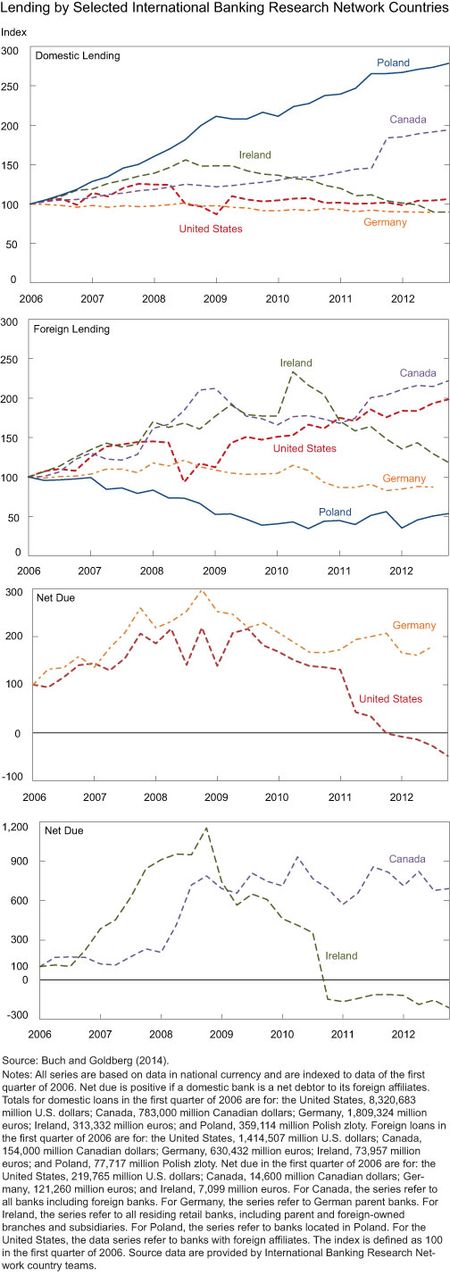Claudia M. Buch, James T.E. Chapman, and Linda S. Goldberg
Over the past thirty years, the typical large bank has become a global entity with subsidiaries in many countries. In parallel, financial liberalization has increased the interconnectedness of banking systems, with domestic banking systems becoming more exposed to shocks transmitted through foreign banks. This globalization of banking propagated liquidity risk during the global financial crisis and subsequent euro area crisis. Unfortunately, little is known about how cross-border operations of global banks transmit liquidity shocks between countries. The seminal work by Peek and Rosengren (1997, 2000) provides early examples of how bank-level data can help identify the specific transmission channels. There are, however, two limitations to conducting this line of research. First, there is a lack of public data on the balance sheets of global banks. Second, it is difficult to compare the results of different research projects that use sensitive supervisory data collected by banking supervisors and central banks. Together with other scholars, we established the International Banking Research Network (IBRN) to overcome these limitations.
In its first full project year of 2013, the IBRN brought together researchers from a dozen central banks: Austria, Australia, Canada, France, Germany, Hong Kong, Ireland, Italy, Poland, Spain, the United Kingdom, and the United States, along with International Monetary Fund and Bank for International Settlements representatives. The goal of the IBRN is to conduct coordinated research using bank-level data to analyze issues pertaining to global banks. IBRN participants agree on a common research question and appropriate econometric specifications. Each central bank research team uses its respective micro-data (including supervisory data) to answer the common question, with scope for individualized applications. The purpose of this approach is to facilitate cross-country comparisons. The transmission of liquidity shocks in lending and through balance sheet exposures of domestic and global banks was the first project chosen and completed by the group, resulting in a series of research papers with authors from the participating countries.
The work conducted by the IBRN uses a methodology based on the work by Khwaja and Mian (2008) and Cornett, McNutt, Strahan, and Tehranian (2011), and extended as described in Buch and Goldberg (2014). Among the starting points for understanding the effects of liquidity shocks is the observation, underscored in the charts below, that different categories of lending—domestic lending, foreign lending, and net intrabank lending—followed quite distinct trajectories across countries.
Each of twelve country teams estimated a panel regression of the domestic banks (both globally active and purely domestic). The variables of interest were the change in various measures of bank balance-sheet line items that could affect the response of lending to liquidity measures such as foreign loans by the bank or net-due balances from foreign affiliates. The independent variables included various (lagged) controls such as the bank’s capital ratio, proxies for size, and various measures of liquidity risk. The risk metrics included a country-specific Libor-OIS spread to measure market liquidity as well as measures of official liquidity support during the crisis.
Buch and Goldberg (2014) conduct a meta-analysis on the individual countries results. Several results are observed:
- The common methodology better explains cross-sectional differences in lending by internationally active banks than lending by purely domestic banks.
- The channels of transmission of liquidity shocks to bank lending differ across banks. Deposit funding matters more for the domestically oriented banks. In contrast, internal liquidity management strategies and official liquidity support matter more for the banks with foreign affiliates.
- The common empirical model explains more of the cross-sectional and time-series variation in domestic lending than in net-due-to (such as intrabank lending) or foreign lending. This finding suggests higher stability of domestic lending. At the same time, we see cross-border lending growth is more sensitive to liquidity risk in relation to the balance sheet characteristics of the banks. An interpretation is that cross-border lending tends to be subordinated to domestic lending activity as stress conditions change.
The individual country studies conducted by the IBRN represent the first systematic look at individual banks across countries using a common methodology. This initial effort provides insights that contribute to the debate about appropriate regulatory responses to liquidity risks and other shocks. More information about the IBRN activities and relevant studies can be found on its website and at the Halle Institute for Economic Research’s International Banking Library.
Disclaimer
The views expressed in this post are those of the authors and do not necessarily reflect the position of the Federal Reserve Bank of New York or the Federal Reserve System. Any errors or omissions are the responsibility of the authors.
Claudia M. Buch is a deputy president of the Deutsche Bundesbank.
James T.E. Chapman is an assistant chief in the financial stability department at the Bank of Canada.

Linda S. Goldberg is a vice president in the Research and Statistics Group of the Federal Reserve Bank of New York.











 RSS Feed
RSS Feed Follow Liberty Street Economics
Follow Liberty Street Economics